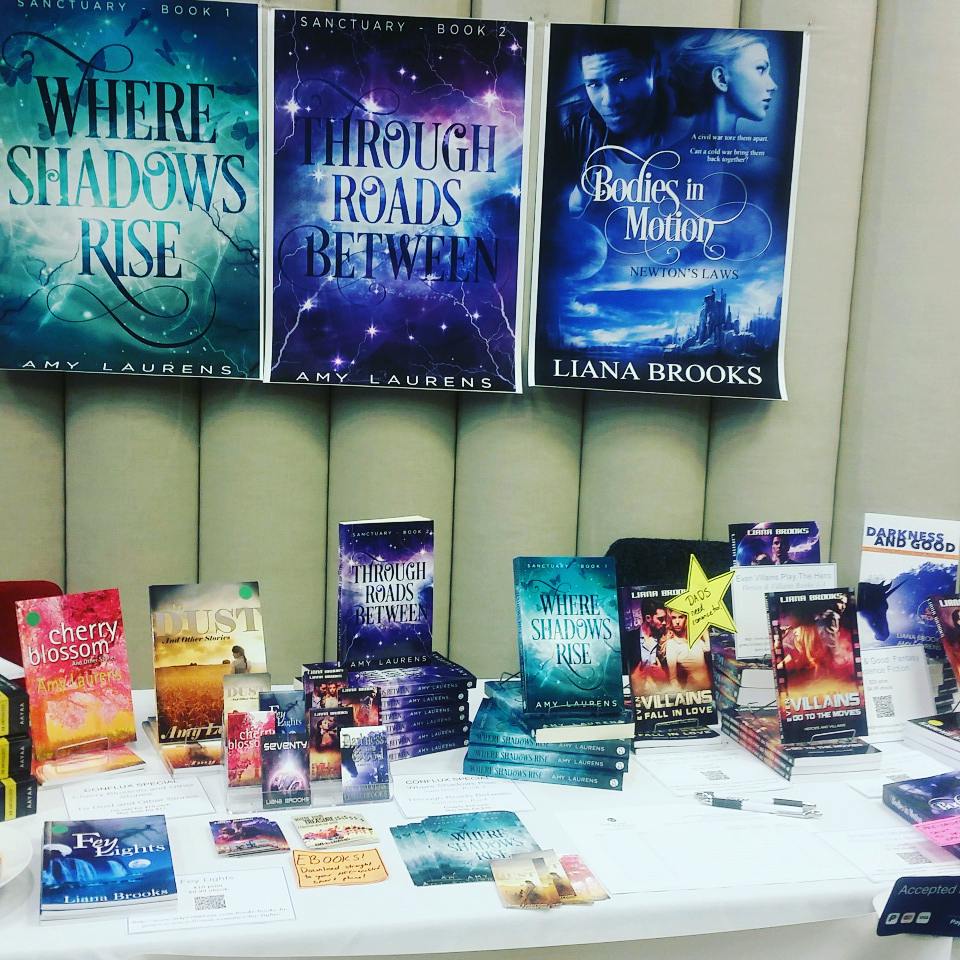
Inkprint Press books at a con in Australia. Look at all the pretty books!
So, you want to write a book? Good for you!
Maybe you’ve daydreamed about being a Real Author for years. Maybe you set a goal as a child to pen the next Great Novel. Maybe you have hazy, romantic ideas about what authors do (spoiler alert: we sit at our computers in pajamas a lot). Whatever the reason is, you want to write a book and that’s an amazing goal!
The first step to writing anything is to figure out what you want to write.
The first thing you need to recognize is that you already know how stories go. You know what you like. You have been exposed to enough stories in your time that you know how they are supposed to go. Keep that certainty with you, because there is going to be a point in writing where you forget this and it can kill your dream if you let it.
The second thing you need to recognize is that writing is hard. Getting a perfect story on the page takes more than intuition and experience at reading stories. Being a reader is like flipping a light switch and knowing that the lights are supposed to turn on. Being an author is like generating electricity, inventing a light source, building the house, and installing the switch. The end results are both light, but there’s more technical know-how and hard work when you’re the author/engineer.
Following the light switch analogy, this How To is a guide to figuring out what kind of light source you want to create. Are you making a big lamp, a spotlight, a nightlight? Are you writing romance, horror, sci-fi? Are you writing short fiction or a novel? What story are you going to write?
There are two basic ways that story ideas come to author…
1 – The story jumps out and mugs them, the ideas overflow, and imagination takes over.
2 – The author goes story hunting, plays with ideas, fails a few times, finds something that works, and imagination takes over.
Most authors have both kinds of stories during their careers. Sometimes you wake up from a dream with the shred of a story. Sometimes you read a headline and go, “Someone ought to write that.” Sometimes you sit down for a few hours sketching out ideas until something starts to gel. This is a primer to get the story ideas flowing.
1 – List Your Favorite Stories
Broad generalities are fine. Titles are fine. “I love Cinderella stories.” “I love Ocean’s 12 but not 11.” “I love murder mysteries.” … great! Write all those down. Try to come up with at least 10.
2- Find The Common Threads
Compare your favorite stories and see what they have in common. Make a list of 7 of the overlapping themes/ideas/emotions. This will be the base template for your book and your author brand. This is what grabs your attention, fires your imagination, and makes you happy. That means this is what you should write.
3- Start Making High Concept Pitches
THIS meets THAT in NEW LOCATION
Look at your list of favorite stories. Start mixing and matching. “Cinderella meets Ocean’s 11 in Space.” – “Robin Hood meets Boyz To Men on a Cruise Ship” – “Harry Dresden in The Revolutionary War” …. fair warning: not all of these will work. Make a list of 10 to 20 ideas. Make them wild and outrageous. Make them silly. Make them gruesome. Don’t overthink it, just throw words at the page. You are hunting a story here, not committing to a life together.
4- Ask Why
Let’s say your idea is “Lucrezia Borgia meets A Pizza Guy in the TARDIS” (this is a real short story, by the by, not one of mine, but bonus points if you can name the anthology it was published in)… How? Why? Why is Lucrezia ordering pizza? Why is she meeting a pizza delivery person? Why is the TARDIS there?
5- Answer Your Questions
Obviously Lucrezia isn’t going to cook dinner for the twenty people she needs to kill, so ordering pizza from a time traveling pizza delivery company is a great idea! Just add poison for that “Made By Borgia” taste they love!
Every story happens for a reason.
We do not tell stories about the unchanging events. Those are reports. Stories always center on change. We don’t need five hundred pages of routine life, but five dazzling pages about the moment everything changes. The moment the sun rises on the dark landscape. The moment the sun sets. Answering WHY and HOW things change give you the shape of a story. If you get stuck ask WHY again.
6- Write The Basic Outline
Answer your WHY in 500 words or less. Your first sentence should name the main character, their first goal, and their first obstacle. Every sentence after that is filled in by asking “How does the character deal with the obstacle?” and “What comes after that reaction?”
You aren’t trying to write a full outline here. You aren’t plotting your twists. This is simply a sketch to see if you can make this idea stand up on it’s own.
Write three or four of these, take a break, and see which one you’re still interested in writing a week later (don’t be surprised if a better idea comes along while you’re thinking). The story that tackles you at midnight is the one you want to work on.
NEXT TIME: How to Plot a Book – Getting from Idea to Page 1
Want More? The expanded version of this post with examples and more information is available to Patreon supporters.


